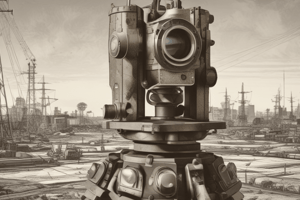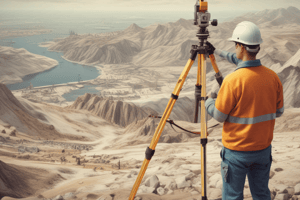Podcast
Questions and Answers
2023-2024 Reading Materials Online Help in , Engineering ______ on YouTube, or Web Surveying forum
2023-2024 Reading Materials Online Help in , Engineering ______ on YouTube, or Web Surveying forum
Surveying
Books - for example, – – – – – Engineering Surveying 6th ed. W. Schofield and M. Breach Engineering ______
Books - for example, – – – – – Engineering Surveying 6th ed. W. Schofield and M. Breach Engineering ______
Surveying
Theory and Examination Problems for Students, V2, 2nd ed. Surveying Engineering & instruments. Valeria Shank ______
Theory and Examination Problems for Students, V2, 2nd ed. Surveying Engineering & instruments. Valeria Shank ______
Surveying
Surveying; problem solving with theory & objective type questions. ADJUSTMENT COMPUTATIONS, Spatial Data Analysis 4th ed. CHARLES D. GHILANI and PAUL R. ______
Surveying; problem solving with theory & objective type questions. ADJUSTMENT COMPUTATIONS, Spatial Data Analysis 4th ed. CHARLES D. GHILANI and PAUL R. ______
Elementary Surveying, an introduction to Geomatics, 13th ed. CHARLES D. GHILANI and PAUL R. ______
Elementary Surveying, an introduction to Geomatics, 13th ed. CHARLES D. GHILANI and PAUL R. ______
Fundamentals of SURVEYING 2nd Year Theory ( 2hr ) , & Practical (2hr) Theory ( 2un.)+Practical ( 1 un.) = 3 Units By : Sami M. Gilyana M.Sc(Surveying), University of ______
Fundamentals of SURVEYING 2nd Year Theory ( 2hr ) , & Practical (2hr) Theory ( 2un.)+Practical ( 1 un.) = 3 Units By : Sami M. Gilyana M.Sc(Surveying), University of ______
Sc(Surveying), University of ______ 1982 Course evaluation – 1st & 2nd semester 1st exam Total =50 (20 theory, 10 practical, 20 activity) – 1st & 2nd semester final exam Total = 50 (40 theory, 10 practical) Course assessment – – – – Very good good Satisfactory Sufficient – Insufficient 87.5 - 100 % 72.5 - Less than 87.5 % 57.5- Less than 72.5 % 50 - Less than 57.5 % 0– Less than 50 % You’re required to achieve a minimum of 50% to pass the course. Theory First Semester No Sub Week hrs 1 History of ______ , Definitions & Basic Principles( surveying, geoid , spheroid, datum) 1-2 4
Sc(Surveying), University of ______ 1982 Course evaluation – 1st & 2nd semester 1st exam Total =50 (20 theory, 10 practical, 20 activity) – 1st & 2nd semester final exam Total = 50 (40 theory, 10 practical) Course assessment – – – – Very good good Satisfactory Sufficient – Insufficient 87.5 - 100 % 72.5 - Less than 87.5 % 57.5- Less than 72.5 % 50 - Less than 57.5 % 0– Less than 50 % You’re required to achieve a minimum of 50% to pass the course. Theory First Semester No Sub Week hrs 1 History of ______ , Definitions & Basic Principles( surveying, geoid , spheroid, datum) 1-2 4
Types Of ______ 3 2
Types Of ______ 3 2
Scales & Units Of ______ 4_5 4
Scales & Units Of ______ 4_5 4
Measurements & ______ 6-7 4
Measurements & ______ 6-7 4
Distances Measurement & ______ 8-9 4
Distances Measurement & ______ 8-9 4
Chain ______ 10-11 4
Chain ______ 10-11 4
Leveling ( principles , Types , testing , Booking , ______ ) 12-13-14-15 6
Leveling ( principles , Types , testing , Booking , ______ ) 12-13-14-15 6
History of Surveying The Early Days Of Surveying – 2700 BC by Egyptian Great Pyramid by using ______. basic – 1400 B.C by Egyptian land division into plots for the purpose of taxation. – Romans were the Next an official land surveyor was employed by the empire History of Surveying The Early Days Of Surveying – 120 B.C Greeks developed the science of geometry and were using it for precise land division. Greeks developed the first piece of surveying equipment (Diopter). Greeks standardized procedures for conducting surveys. History of Surveying The Early Days Of Surveying – 1800 A.D. – Beginning of the industrial revolution. - "exact boundaries" importance. - demand for public improvements (i.e. railroads, canals, - More accurate instruments were developed. - Science of Geodetic and Plane surveying were developed. roads). History of Surveying Chain Compass Plane table Barometer Alidade SURVEYING may be defined as the science , art and technology of determining the position, in three dimensions, of natural and man-made features on or beneath the surface of the Earth.
History of Surveying The Early Days Of Surveying – 2700 BC by Egyptian Great Pyramid by using ______. basic – 1400 B.C by Egyptian land division into plots for the purpose of taxation. – Romans were the Next an official land surveyor was employed by the empire History of Surveying The Early Days Of Surveying – 120 B.C Greeks developed the science of geometry and were using it for precise land division. Greeks developed the first piece of surveying equipment (Diopter). Greeks standardized procedures for conducting surveys. History of Surveying The Early Days Of Surveying – 1800 A.D. – Beginning of the industrial revolution. - "exact boundaries" importance. - demand for public improvements (i.e. railroads, canals, - More accurate instruments were developed. - Science of Geodetic and Plane surveying were developed. roads). History of Surveying Chain Compass Plane table Barometer Alidade SURVEYING may be defined as the science , art and technology of determining the position, in three dimensions, of natural and man-made features on or beneath the surface of the Earth.
SURVEYING may be defined as the science , art and technology of determining the position, in three dimensions, of natural and man-made features on or beneath the surface of the Earth. These features may then be represented in analog form as a contoured map, plan or chart, or in digital form as a three dimensional mathematical model stored in the computer. This latter format is referred to as a digital ground model (DGM). The physical surface of the Earth, on which the actual survey measurements are carried out, is mathematically NON-DEFINABLE. It cannot therefore be used as a reference datum on which to compute position. An alternative consideration is a level surface, at all points normal to the direction of gravity. Such a surface would be formed by the mean position of the oceans. This surface is called the geoid and is the ( equipotential surface at mean sea level). The reduced level or elevation of a point is its height above or below the geoid as measured in the direction of its gravity vector (or plumb line) and is most commonly referred to as its height above or below mean sea level (MSL). is an ellipsoid formed by rotating an ellipse about its minor axis. Where this shape.
SURVEYING may be defined as the science , art and technology of determining the position, in three dimensions, of natural and man-made features on or beneath the surface of the Earth. These features may then be represented in analog form as a contoured map, plan or chart, or in digital form as a three dimensional mathematical model stored in the computer. This latter format is referred to as a digital ground model (DGM). The physical surface of the Earth, on which the actual survey measurements are carried out, is mathematically NON-DEFINABLE. It cannot therefore be used as a reference datum on which to compute position. An alternative consideration is a level surface, at all points normal to the direction of gravity. Such a surface would be formed by the mean position of the oceans. This surface is called the geoid and is the ( equipotential surface at mean sea level). The reduced level or elevation of a point is its height above or below the geoid as measured in the direction of its gravity vector (or plumb line) and is most commonly referred to as its height above or below mean sea level (MSL). is an ellipsoid formed by rotating an ellipse about its minor axis. Where this shape.
Flashcards are hidden until you start studying




